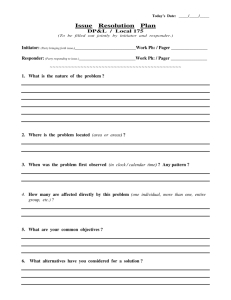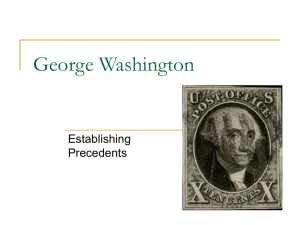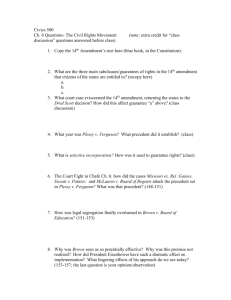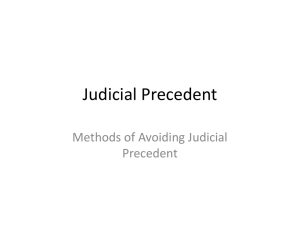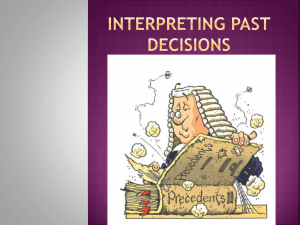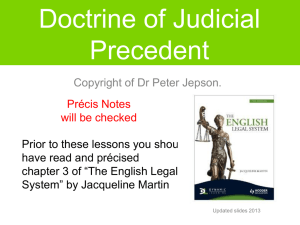Unit 4 - Precedent Book
advertisement
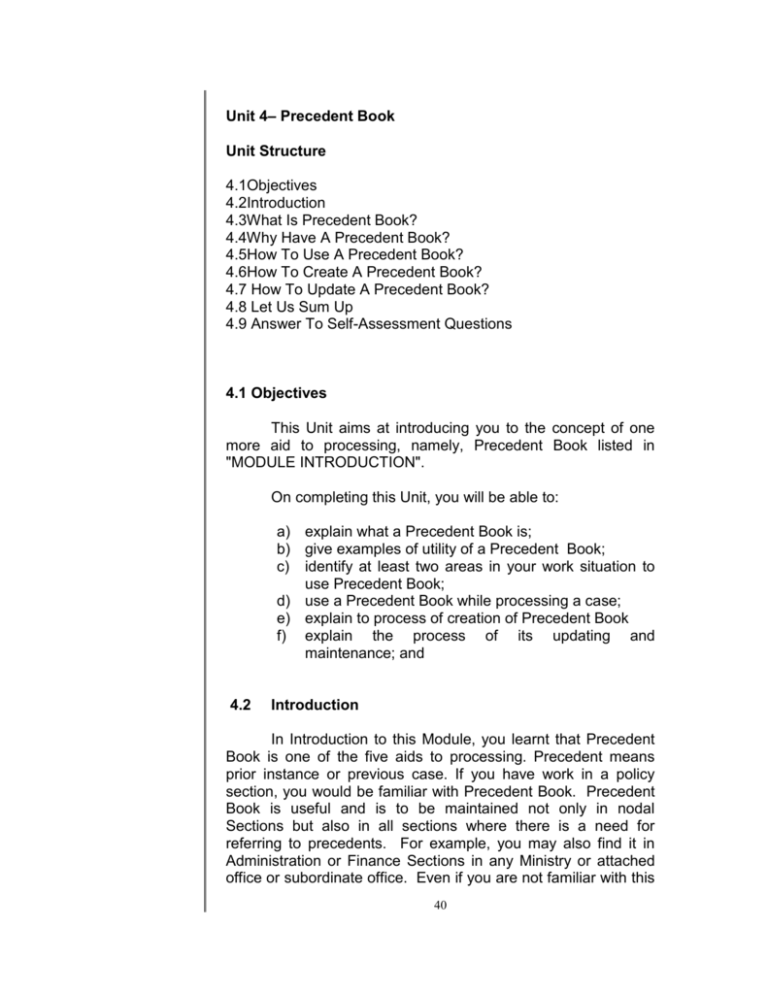
Unit 4– Precedent Book Unit Structure 4.1Objectives 4.2Introduction 4.3What Is Precedent Book? 4.4Why Have A Precedent Book? 4.5How To Use A Precedent Book? 4.6How To Create A Precedent Book? 4.7 How To Update A Precedent Book? 4.8 Let Us Sum Up 4.9 Answer To Self-Assessment Questions 4.1 Objectives This Unit aims at introducing you to the concept of one more aid to processing, namely, Precedent Book listed in "MODULE INTRODUCTION". On completing this Unit, you will be able to: a) explain what a Precedent Book is; b) give examples of utility of a Precedent Book; c) identify at least two areas in your work situation to use Precedent Book; d) use a Precedent Book while processing a case; e) explain to process of creation of Precedent Book f) explain the process of its updating and maintenance; and 4.2 Introduction In Introduction to this Module, you learnt that Precedent Book is one of the five aids to processing. Precedent means prior instance or previous case. If you have work in a policy section, you would be familiar with Precedent Book. Precedent Book is useful and is to be maintained not only in nodal Sections but also in all sections where there is a need for referring to precedents. For example, you may also find it in Administration or Finance Sections in any Ministry or attached office or subordinate office. Even if you are not familiar with this 40 aid to processing, this unit should introduce it to you. The chances are that you too would like to have a Precedent Book in your section because of the utility it provides. It is also possible that you could be motivated to identify some of the cases you have dealt with which are of precedent value and update the Precedent Book you already have in the section. Or you may even take initiative in building a new Precedent Book in your section. 4.3 What Is A Precedent Book? You are aware that while taking action on receipts, you are to examine cases with reference to the rules, regulations or guidelines on the subject. There are, however, instances when you come across cases where the rules, the regulations or the guidelines do not provide clear and specific answer for the issue you are considering. That is the time you look for precedents. The Manual of Office Procedure suggests maintaining an aid to help you on such occasions. It is called "Precedent Book" It is a valuable tool for quick retrieval of past files on the subject under consideration. It is a Register designed to keep note of important rulings or decisions having a precedent value for ready reference. One more important information you will find in it is the details regarding file number in which the decision having a precedent value was recorded. If there is no precedent you are to seek advice from the nodal Ministry concerned. Often this sort of references result in delay in disposal of cases. This is mainly because the note sent may not cover all the issues clearly. Or, the nodal Ministry may seek additional information to decide the case. If a precedent does exist and you suggested making a reference to the nodal Ministry, you would contribute to delay in the decision making process. Now that you have some idea about Precedent Book, think for a while and record in the box below, what you consider are the details that should be entered in a Precedent Book. If possible design a format in which you would like to have those details. 41 In-Text Activity 42 The Manual of Office Procedure suggests a format, which is as under: PRECEDENT BOOK HEADING:_____________________________________________________ DECISION OR RULING IN BRIEF FILE NO The format available in the Manual of Procedure (Appendix-27 of the eleventh edition (1996) provides space to record the three aspects of information for which you may refer to it --the subject title, the decision and the file number. The Precedent Book in most of the Sections is maintained in a thick bound register of 200 pages or so. If you want to use more space for entering details of decisions, you may consider the following format: PRECEDENT BOOK 43 Heading: Decision or ruling in brief Date: Copy at page 4.4 File No. in the folder. Why Have A Precedent Book? The reasons for having a precedent Book in the section are: (a) (b) to know whether there is any decision taken earlier on the issue presently under consideration; If so, to have the old file number in which the decision was taken for locating it and linking it with the current file. It is thus, helpful in quick retrieval of information/ file and saves a lot of time. For example, you may be dealing with the case of "Appointment to the post of Chairman, Central Electricity Authority". You may have to answer a query on the file as to whether there has been any past instance(s) where an officer other than the one belonging to the Central Power Engineering Service has ever been a Chairman. If you have been working in the Section for ten years or so, you may remember some such instance. Or you would know that Guptaji used to deal with if you are new to the section, you may ask your last few predecessors-- apart from all your present colleagues in the section-- to help you. In all of these instances, you could consider yourself lucky if you get some details like the name of such an officer or the year in which the file was opened. There 44 have been instances in almost all Ministries when people had spent days to just get file number of such cases with precedent value! 4.5 How To Use A Precedent Book? You know that Precedent Book is maintained in a Register. The Register has all its pages numbered. A few pages are allotted to each standardised heading. You make entries under appropriate headings. These headings are arranged in an alphabetical order. In case your office follows conventional filing system, you will only have standard-heads and sub-heads. On the other hand, if functional filing system is followed in your office, entries will be made under the appropriate basic head, primary head and tertiary head. A few pages are allotted to each standardised heading. This list of headings and page numbers allotted is pasted on the first page of the Register. To use the Precedent Book, you to have to go through the alphabetical order list of standardised subject headings. For example, if you are looking for a precedent to decide a case on seniority, look for alphabet 'S' in the register. You will find the pages allotted to it. Turn over to that page and you will have details of the case. After going through the decision recorded on the relevant page, if you want to see the file, you have the details of file number to. Then you have locate the file and read it. If necessary, you may link it with the current file and submit it to the competent authority for a decision on similar line. After the file is received back in the section, the old file with precedent value will be de-linked and returned to its place. 4.6 How To Create A Precedent Book? Creating a Precedent Book is similar to using it. But first locate files with precedent value. It is difficult to define the term "precedent value". You cannot take a rigid view on this that the entries in this register should be only 'decisions' or 'precedents'. You may also make entries relating to discussions on file leading to 'no decision' or 'non-precedents' also. ' No decision' cases are those which are examined in a file for a decision but the final outcome is to keep it on hold. For example, processing a proposal for creation of posts. Let us say that shortly after this issue is under consideration, an exercise for cadre review is taken. A view may be taken to hold up the proposal for creation of posts till the cadre review is completed. This is an instance 45 where discussions on file have lead to 'no decision'. If considered suitable, this 'no decision' may be a fit case for entry in the precedent Book. Similarly, you may examine a proposal to grant relaxation to one of the eligibility conditions provided in recruitment rules for promotion. After discussions on the file, the Department of personnel, the nodal authority in such cases, may not agree to the proposal. Strictly speaking, this is an instance of 'non- precedent', as relaxation was not given; but still in your Ministry this would be a case with a precedent value The precedent value is that no relaxation was granted! You would now appreciate that the only criterion to decide whether or not a case should be entered in the Precedent Book is on the basis of whether such a file is likely to be called up for reference in the near or distant future. Those of you with some experience of having used a Precedent Book may have noticed that even though it does give a gist of the decision taken and the file number, you cannot submit it as an authentic document to your senior officers while examining a fresh case of similar nature. They may like to see the old file to decide the new case. That is when your problem may start! You may not be able to locate the old file! A possible solution to this problem may be considered by going beyond the provisions made in the Manual of Office Procedures. You may consider taking photocopy of the relevant correspondence and the notes portions of the file with precedent value and keep them systematically in a folder. Systematically would mean giving a fresh page number to the photocopied papers and keeping a record in the form of an index on the first page of the folder. You may also note the page reference in the Precedent Book. Between one set of photocopy of a precedent and another, you may keep a blank colored sheet as a separator. This folder should be kept along with the Precedent Book in a file board. This kind of an institutionalised system would obviate the need to locate the old file. The Precedent Book along with the folder-containing photocopy of the relevant note/ correspondence portions should be kept in a safe place. It would not be a bad idea to assign this responsibility to someone in the section through a specific entry in the work-allocation chart in the section. You must have seen that a large amount of noting is recorded before a decision is taken. There are instances where noting may run across 15 to 20 pages. You would like to have such 46 details recorded in the Precedent Book. This is because you use it to save your processing time by giving crisp and important details therefore, before making an entry in the Precedent Book there is a need to have a draft of the decision you are to enter in it. If you keep photocopy of the relevant note portion then, the need to prepare the draft could be obviated. You only need to give the broad details of the decision taken. Example: One more aspect to be kept in mind while creating Precedent Book is to make entries under different headings, like you to indexing of files recorded under category 'A' (you will read the details of records management in Module- 7 of this Course). For example, a file containing decision of precedent value is titled "appointment to the post of Chairman, Central Electricity Authority". The decision relates to the age limit of the candidate chosen for appointment. Subsequently, one Shri M.K. Gupta is appointed. In the precedent book entries for this precedent could be made under "appointment ", "Chairman, CEA ","Age Relaxation", "Eligibility Conditions" and "M.K. Gupta". 4.7 How To Update A Precedent Book? Like any other aids to processing, Precedent Book too would lose its utility unless it is up-to-date. This is so because there could be a review of the precedent to meet the current requirements. Further, there could be new precedents on other subjects. To update the Precedent Book you are to follow the same procedure given in Section 4.6. An interesting question normally asked while considering the task of updating Precedent Book is not the 'How' aspect but the ' when' aspect. There are people who make entries in the Precedent Book immediately after taking decisions. There are others, who prefer to do so at the stage of recording the file. Those who belong to the later school of thought are basically those who would like to follow one of the provisions given elsewhere in the Manual of Office Procedure. In Chapter XI [para 98, sub-para 1(d)] of the 1996-eleventh edition, the Manual gives detailed steps to be taken for recording a file. One of the action listed there is that the dealing hand should extract from the file, copy of important decisions, documents which are considered useful for future reference and add them to the Standing Guard File or the Precedent Book. This is only an enabling provision to remind people that at least at the stage of recording a file, action should be taken to update the Precedent 47 Book. The general experience in government office is that record management is not given the kind of importance it deserves. Therefore, many valuable decisions of precedent nature remain hidden in the files. There have been many instances where cases of similar nature have again been processed with fresh application mind by 6 to 12 or even more officers depending on the decision making levels! Interestingly, there are a few instances where two diagonally opposite decisions have been taken in two cases of similar nature. An ideal time to make entries in the Precedent Book, therefore, is immediately after a decision of precedent value is taken. However, in any case, the entry must be made at least at the stage of recording the file. In case, work in your section is reasonably computerised, you can have the Precedent Book built in it. The procedure is the same as given in Sections 4.6 and 4.7. The only thing you have to do is to create a template in the format given in Section 4.3. 48 4.8 Self-Assessment Questions Indicate whether the following statements are 'Correct' or 'Incorrect' by putting a tick or cross mark in the space provided against each: 1. Precedent Book is to be maintained only in Sections dealing with policy matters. ( ) 2. Looking for precedent generally is a time consuming work. It is, therefore, better to process a fresh case again and take decision. ( ) 3. Precedent Book helps in reducing the time to process case. ( ) 4. Precedent Book is printed on an annual basis. ( ) 5. Precedent Book is systematically divided into sub-sections for each standardised subject head dealt with in a section. ( ) 6. Even cases where discussions on a file did not lead to a decision can be entered in the Precedent Book. ( ) 7. The guiding principle to determine whether a 'decision' or 'nondecision' is to be entered in the Precedent Book is whether the file containing such a 'decision' or 'non-decision' is likely to be required in the future. ( ) 8. Entry in the Precedent Book is to be made only at the stage of recording the file. ( ) 4.9 Let Us Sum Up Precedent Book is an aid to processing. It helps in saving your time while taking action on a case. It contains details of decision taken on a case in the pas case, which is not covered by the provisions contained in the rules or the guidelines. You would have normally consulted the nodal authority while taking such 49 decisions. The Precedent Book also gives the file number for locating it and linking it with the current file. It has to be updated on a regular basis. The best way is to make an entry of the decision with precedent value immediately. In any case, do make an entry at least at the time of recording a file. Senior officers normally want to see the old file before clearing the current file. To save your time to locate the old file, you may retain photocopy of the relevant notes/correspondence portions and keep them systematically in a folder. The folder and the Precedent Book could be kept together in a file board. Before you proceed first, reflect upon the cases you have dealt with in the recent past, say a year or so. Record the decisions contained in the files, which you think, could be called up for reference in the future to process cases of similar nature. All you have to do is just write briefly the details of such decisions. At the end of each such decision create a box like this. This activity will act as the basis for you and your colleagues in your Section to build or update Precedent Book. In-Text Activity 50 4.9 Answers To Self-Assessment Questions These are only suggested answers. variations There could certainly be 1. Incorrect. While Sections dealing with policy matters must maintain Precedent Book, even other Sections that often depend on precedents must also maintain it. You have read the details in Section 4.2 2. Incorrect. It is time-consuming only when a Section does not systematise its precedents. Maintenance of Precedent Book will, in fact, greatly reduce the processing time. This is because there has already been an application of mind by a team of people in the past. Unless, there is a need to review the past decision to meet the present changed requirement, processing cases when a precedent is cited reduces the processing time. Secondly, processing a similar case again just because you are unable to locate the precedent could lead to taking arbitrary and, at times, conflicting decisions on cases of similar nature. 3. Correct. Explanation given for 2 is also applicable here. 4. Incorrect. It is hand written in a register or keyed in the computer system as soon as the decision is taken. 5. Correct. 6. Correct. You will find the clarification in question 7! 7. Correct. 8. Incorrect. Entry should be made as soon as the decision is taken. Otherwise, you will not enjoy the benefits of the Precedent Book till the recording of the file, which could even take years! In any case, entry must be made at the stage of recording the file. 51
